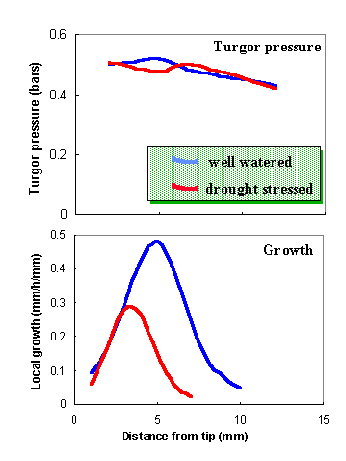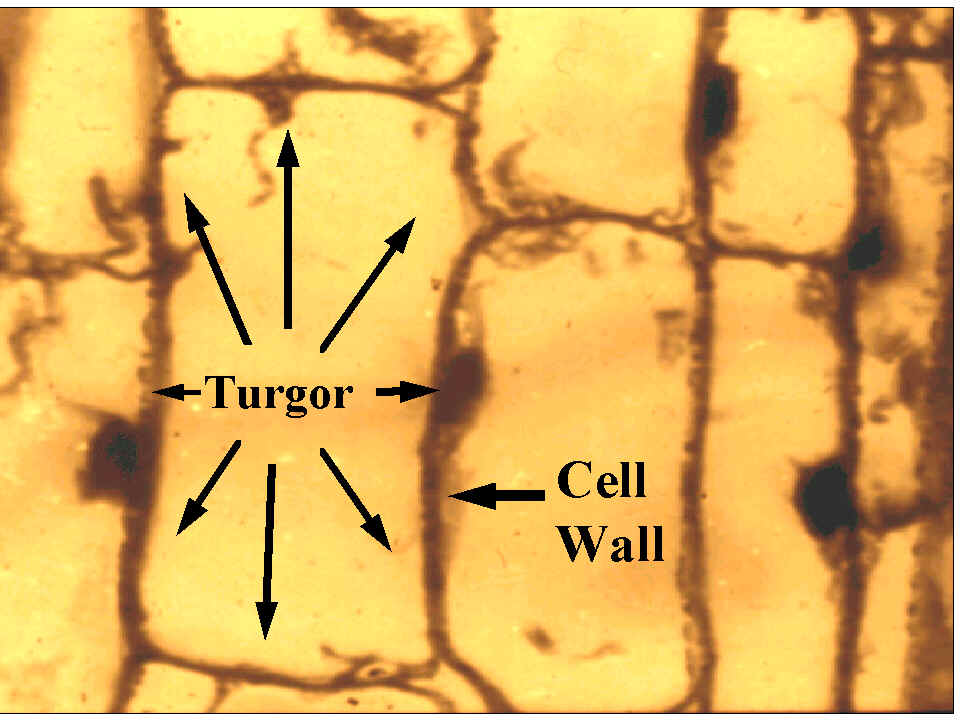
Cell extension: the role of turgor pressure and cell wall properties
We are interested in the physiological and biochemical processes which control plant cell expansion. Techniques for the measurement of turgor and osmotic pressure in single cells are central to these studies. The growing root provides a simple experimental system in addition to its central role in the physiology of the plant. We are studying the response of plant growth to environmental fluctuations such as drought, salt, temperature, minerals and soil compaction.
Spatial analysis of root
biophysics following drought
Turgor pressure measured with the pressure pobe is found to be fairly constant along the root growing zone. In contrast growth rate varies considerably along the root apex. The constant turgor indicates that this variation in growth is due to loosening and tightening of the cell wall.
Turgor is often maintained following drought, despite this the growth profile is modified in comparison with well watered roots indicating that alteration of cell wall properties has a role in regulating plant growth following drought. The role of wall biochemistry, particulary acid growth, is studied in another project.
Other work has examined the hypothesis that
rapid changes in the extension rate of cells in maize roots are regulated by alterations in the
ionic composition of the cell apoplast, particularly pH (so called acid growth).
of cells in maize roots are regulated by alterations in the
ionic composition of the cell apoplast, particularly pH (so called acid growth).
The root apoplast is the interface at which the plant encounters the environment. This project provided information on the degree of control exerted by roots on their apoplast. It is relevant to an understanding of the cell wall biochemistry underlying the control of extension growth and ion uptake by plant cells. These two aspects have ecological relevance in the exploitation of soil volume by root systems.
The major conclusion of this work is that cell growth is driven by turgor pressure but regulated by changes in cell wall properties. Some of this work is summarised in this review.
 Root growth is affected by drought. The effects of osmotic stress on cell wall
loosening can be examined to provide an understanding of the effect of drought on root
elongation. The abstract of a poster presenting some of this work can be found here.
Root growth is affected by drought. The effects of osmotic stress on cell wall
loosening can be examined to provide an understanding of the effect of drought on root
elongation. The abstract of a poster presenting some of this work can be found here.
Growth can be measured at high resolution using time-lapse photography. Cell turgor pressure can be measured using the pressure probe and osmotic pressure evaluated by picolitre osmometry. Cell wall properties may be examined by comparing growth and turgor pressure along the growing region and manipulating turgor pressure and following effects on growth rate. Ionic composition of the cell wall can be measured using ion-sensitive microelectrodes.
We are also exainig the effect of drought on the extenion of barley leaves usign similar approaches to those we use for roots